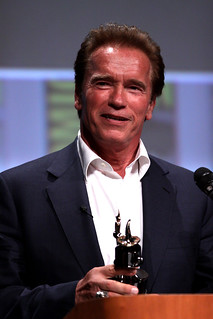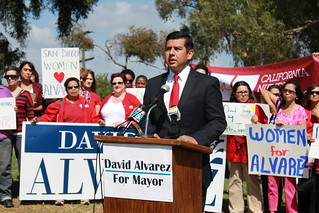 Former Governor speaks out on redistricting and top two reforms
Former Governor speaks out on redistricting and top two reforms
by Brian Leubitz
Governor Arnold Schwarzenegger had his ups and downs as governor. He peaked That’s not all that abnormal, but with him it was entirely predictable. When he went toward the middle/leftish, he was up. When he veered hard right, he went down. 2005 hard-right special election? Down. AB 32? Up. And, more relevant here, redistricting measures? Up. You can check his approval rating history here.
And so he’s trying to craft his legacy around the government reforms that have largely been quite popular. He’ll be speaking at USC this morning about redistricting and Top-2. Yesterday, he published an op-ed that lets us know which victory lap he’ll be taking.
Many of us believed, and voters agreed, that the two reforms in combination would put California on a path toward breaking up gridlock and hyper-partisanship, and making government work better for our citizens.
We were basing our efforts on common sense and a commitment to putting people over politics. And now, the early results are starting to come in, and they show that these reforms are working.
In 2012, the top-two primary yielded 28 elections that, for the first time, pitted members of the same party against one another. Also, legislative districts that previously had been gerrymandered to protect politicians were no longer “safe” for one party or the other. … This year’s races could shake things up even more, as candidates for office are forced to appeal to all voters, not just the party bosses.(Arnold Shwarzenegger in SF Chronicle)
Now, I think he has a few fair points in the op-ed. I was a strong opponent of the redistricting system when it was on the ballot, both times actually. But I’m big enough to admit that I was wrong. The system was far more responsive to the needs and desires of the voters, rather than the legislators. The process was transparent as any we have seen, and the results were fair. Sure, there were some who were disappointed by the results, but a fair system was always likely to upset some of the entrenched apple carts.
But, as for top two, the system clearly has some big flaws. First, despite his claims that somehow the primary system allowed “party bosses” to choose, the primary system was made up of voters. There is no better example of this than the Tea Party, an insurgent force within the Republican party. How many times have we now seen the wishes of party bosses completely ignored at the ballot box? And let’s face it, the “party bosses” are bosses in name only these days. The bosses are really the big independent expenditure funding campaigns. Where they go, eventually our politics follows.
But the bigger issue of Top 2 is the troubling results it can sometimes yield to triumphs of game theory over the desires of constituents. There is no better example of this than California’s 31st district in 2012. In that election, two well-known Republicans ran against four less well known Democrats in a district with a 15+% Democratic registration advantage. In a relatively low turnout June primary, Democrats received 33,402 votes, and Republicans received 32,265 votes. Yet there was no Democrat on the ballot. This is a brilliant play for Republicans, they picked up a seat they wouldn’t have had otherwise. But, in the end, a plurality of voters in the district did not have an option from their own party. How does that make sense?
Add in the very troubling impacts of Top 2 on third parties, and you have a muddled, confusing, and anti-democratic system that favors parties that game the system with tight party boss control. If your party boss can’t impose discipline, you may end up with no candidates on the general election ballot.
Finally, with all of this, Schwarzenegger’s stated purpose was to create a more “moderate” legislature. In California, that really meant a less progressive, more pro-corporate body. It is hard to deny that Schwarzenegger was at least somewhat successful on that front. Despite the 2/3 Democratic control, many of these Democrats moved the caucus to the right. Now, whether you value the goal of making the legislature more moderate could lead you to differing judgments on Gov. Schwarzenegger. One would hope that a chief goal of structural government reform is to create a legislature that fairly and accurately represents the constituents, but that was never Schwarzengger’s thing. Sure, he had a flair for populist rhetoric, but drifted in other directions when in office.
Schwarzenegger will be talking to the hosts of MSNBC’s Morning Joe, so you will likely be able to see snippets of the conversation on TV. But, from a Governor who finished with an approval rating around 20% in 2010, there is a lot of work left to fully rehabilitate his legacy that a flawed government reform like Top 2 can’t address.


 Added sugar leads to profound health risks
Added sugar leads to profound health risks
 Former Hedge Fund Manager turned climate activist looks to make climate change big 2016 issue
Former Hedge Fund Manager turned climate activist looks to make climate change big 2016 issue

